Field Characterization of Dynamic Response of Geocell-Reinforced Aeolian Sand Subgrade under Live Traffic
Abstract
:1. Introduction
2. Experimental Design
2.1. Experimental Overview
2.2. Monitoring Program
3. Results
3.1. Time–Domain Results of Vibration Velocity Response
3.2. Analysis of Actual Vibration Amplitude
3.3. Frequency–Domain Analysis of Vibration Velocity Response
3.4. One-Third Frequency Range Analysis
3.5. Analysis of the Depth of Influence
3.5.1. Analysis Basis
3.5.2. Analysis Process
3.5.3. Analysis Results
4. Discussion
5. Conclusions
Author Contributions
Funding
Informed Consent Statement
Data Availability Statement
Acknowledgments
Conflicts of Interest
References
- Wang, C.; Li, S.; Li, Z.; Lei, J.; Chen, J. Effects of windblown sand damage on desert highway guardrails. Nat. Hazards 2020, 103, 283–298. [Google Scholar] [CrossRef]
- Yuan, J.; Ye, C.; Luo, L.; Pei, X.; Yang, Q.; Chen, J.; Liao, B. Sand fixation property and erosion control through new cellulose-based curing agent on sandy slopes under rainfall. Bull. Eng. Geol. Environ. 2020, 79, 4051–4061. [Google Scholar] [CrossRef]
- Tang, X.; Xiao, J.; Ma, M.; Yang, H.; Li, X.; Ding, Z.; Yu, P.; Zhang, Y.; Wu, C.; Huang, J.; et al. Satellite evidence for China’s leading role in restoring vegetation productivity over global karst ecosystems. For. Ecol. Manag. 2022, 507, 120000. [Google Scholar] [CrossRef]
- No. JTG 3610—2019; Technical Specifications for Construction of Highway Subgrads. People’s Traffic Publishing House Co.: Beijing, China, 2019.
- Abu Seif, E.-S.S.; Sonbul, A.R.; Hakami, B.A.H.; El-Sawy, E.K. Experimental study on the utilization of dune sands as a construction material in the area between Jeddah and Mecca, Western Saudi Arabia. Bull. Eng. Geol. Environ. 2016, 75, 1007–1022. [Google Scholar] [CrossRef]
- Sun, J.; Gu, S.; Li, J.; An, Y.; Liu, H. Research on Road Performance of Aeolian Sand Subbase Stabilized by DHT Soil Condensate. Highway 2021, 11, 57–62. [Google Scholar]
- Miao, L.; Wu, L.; Sun, X. Enzyme-catalysed mineralisation experiment study to solidify desert sands. Sci. Rep. 2020, 10, 10611. [Google Scholar] [CrossRef]
- Zhang, X.; Pang, S.; Li, J.; Zhang, X.; Cai, G.; Tian, L. Interface Mechanism and Splitting Characteristics of Fiber-Reinforced Cement-Solidified Aeolian Sand. Materials 2022, 15, 2860. [Google Scholar] [CrossRef]
- Lu, Y.; Abuel-Naga, H.; Leong, E.-C.; Jiao, W.-G.; Wang, X. Characterisation of geomembrane and geotextile interface short-term creep behaviour in a dry condition. Geotext. Geomembranes 2021, 50, 312–322. [Google Scholar] [CrossRef]
- Han, X.; Zhang, M.; Li, J.; Jiang, S. Model Test of Sand Foundation Reinforced with High-strength Geocel. J. Yangtze River Sci. Res. Inst. 2014, 3, 27–33. [Google Scholar]
- Sheikh, I.R.; Shah, M.Y. State-of-the-Art Review on the Role of Geocells in Soil Reinforcement. Geotech. Geol. Eng. 2020, 39, 1727–1741. [Google Scholar] [CrossRef]
- Saride, S.; Gowrisetti, S.; Sitharam, T.G.; Puppala, A.J. Numerical simulation of geocell-reinforced sand and clay. Proc. Inst. Civ. Eng. Ground Improv. 2009, 162, 185–198. [Google Scholar] [CrossRef]
- Hegde, A.; Sitharam, T.G. Experimental and numerical studies on footings supported on geocell reinforced sand and clay beds. Int. J. Geotech. Eng. 2013, 7, 346–354. [Google Scholar] [CrossRef]
- Hegde, A.; Sitharam, T. 3-Dimensional numerical modelling of geocell reinforced sand beds. Geotext. Geomembranes 2015, 43, 171–181. [Google Scholar] [CrossRef]
- Song, F.; Liu, H.; Yang, B.; Zhao, J. Large-scale triaxial compression tests of geocell-reinforced sand. Geosynth. Int. 2019, 26, 388–395. [Google Scholar] [CrossRef]
- Tafreshi, S.M.; Rahimi, M.; Dawson, A.; Leshchinsky, B. Cyclic and post-cycling anchor response in geocell-reinforced sand. Can. Geotech. J. 2019, 56, 1700–1718. [Google Scholar] [CrossRef]
- Venkateswarlu, H.; Hegde, A. Effect of infill materials on vibration isolation efficacy of geocell-reinforced soil beds. Can. Geotech. J. 2019, 57, 1304–1319. [Google Scholar] [CrossRef]
- Wan, X.; Ding, J.; Hong, Z.; Huang, C.; Shang, S.; Ding, C. Dynamic Response of a Low Embankment Subjected to Traffic Loads on the Yangtze River Floodplain, China. Int. J. Géoméch. 2022, 22, 04022065. [Google Scholar] [CrossRef]
- Abbaspour, M.; Narani, S.S.; Aflaki, E.; Nejad, F.M. Dynamic characteristics of a sandy subgrade reinforced by waste tire textile fibres. Int. J. Pavement Eng. 2022, 23, 2293–2308. [Google Scholar] [CrossRef]
- Yang, X.; He, Q.; Liu, X.; Yang, F.; Huo, W.; Shen, S.; Mamtimin, A. Saltation activity and its threshold velocity in the Gurbantunggut Desert, China. Nat. Hazards 2018, 90, 349–364. [Google Scholar] [CrossRef]
- Hou, Y.; Wang, B.; Huang, L.; He, W.; Zhu, J.; Wang, J. Mechanical properties of re-packed reinforced Earth embankment during service stage. J. Asian Arch. Build. Eng. 2022, 21, 1520–1531. [Google Scholar] [CrossRef]
- Múčka, P. Sensitivity of road unevenness indicators to short wavelength distresses in Portland cement concrete surfaces. Int. J. Pavement Eng. 2018, 19, 901–916. [Google Scholar] [CrossRef]
- Wan, J.; Li, B.; Gao, Y.; Tan, C.; Feng, C.; Zhang, P. Dynamic response of the inhomogeneous pavement structure containing a buried fault zone under the moving aircraft loads. Bull. Eng. Geol. Environ. 2022, 81, 301. [Google Scholar] [CrossRef]
- Salehi, K.; Eisa, H.M.; Badv, K. Reinforcement effect of geotextiles on shear strength of peat soil: A case study on Urmia peat. Bull. Eng. Geol. Environ. 2021, 80, 6799–6812. [Google Scholar] [CrossRef]
- Zhang, B.-B.; Liu, J.; Gao, B.; Wang, B.; Ai, Y.-H. The Study on Dynamic Response of Aeolian Sand Embankment Strengthened by Geocell through Field Test. J. Highw. Transp. Res. Dev. 2021, 15, 24–35. [Google Scholar] [CrossRef]
- Haghnejad, A.; Ahangari, K.; Moarefvand, P.; Goshtasbi, K. Numerical investigation of the impact of rock mass properties on propagation of ground vibration. Nat. Hazards 2019, 96, 587–606. [Google Scholar] [CrossRef]
- Saha, P.; Mandal, K.K. A study of earthquake-induced vibration on laminated composite plates using finite element method. Nat. Hazards 2021, 106, 2251–2277. [Google Scholar] [CrossRef]
- Li, X.; Wang, Y.; Hu, Y.; Zhou, C.; Zhang, H. Numerical Investigation on Stratum and Surface Deformation in Underground Phosphorite Mining Under Different Mining Methods. Front. Earth Sci. 2022, 10. [Google Scholar] [CrossRef]
- Huang, F.; Cao, Z.; Guo, J.; Jiang, S.-H.; Li, S.; Guo, Z. Comparisons of heuristic, general statistical and machine learning models for landslide susceptibility prediction and mapping. Catena 2020, 191, 104580. [Google Scholar] [CrossRef]
- Liu, Z.; Gu, X.; Ren, H.; Zhou, Z.; Wang, X.; Tang, S. Analysis of the dynamic responses of asphalt pavement based on full-scale accelerated testing and finite element simulation. Constr. Build. Mater. 2022, 325, 126429. [Google Scholar] [CrossRef]
- Chang, Z.; Du, Z.; Zhang, F.; Huang, F.; Chen, J.; Li, W.; Guo, Z. Landslide Susceptibility Prediction Based on Remote Sensing Images and GIS: Comparisons of Supervised and Unsupervised Machine Learning Models. Remote Sens. 2020, 12, 502. [Google Scholar] [CrossRef] [Green Version]
- Li, W.; Han, S.; Han, X.; Yao, Y. Experimental and numerical analysis of mechanical properties of geocell reinforced reclaimed construction waste composite base layer. Constr. Build. Mater. 2021, 304, 124587. [Google Scholar] [CrossRef]
- Huang, F.; Zhang, J.; Zhou, C.; Wang, Y.; Huang, J.; Zhu, L. A deep learning algorithm using a fully connected sparse autoencoder neural network for landslide susceptibility prediction. Landslides 2020, 17, 217–229. [Google Scholar] [CrossRef]
- Tertyshnaya, Y.V.; Karpova, S.G.; Podzorova, M.V.; Khvatov, A.V.; Moskovskiy, M.N. Thermal Properties and Dynamic Characteristics of Electrospun Polylactide/Natural Rubber Fibers during Disintegration in Soil. Polymers 2022, 14, 1058. [Google Scholar] [CrossRef] [PubMed]
- Toyota, H.; Takada, S. Settlement assessment of sand subjected to cyclic stress related to a load moving over a surface using hollow cylindrical torsional shear apparatus. Transp. Geotech. 2021, 29, 100580. [Google Scholar] [CrossRef]
- Huang, F.; Cao, Z.; Jiang, S.-H.; Zhou, C.; Huang, J.; Guo, Z. Landslide susceptibility prediction based on a semi-supervised multiple-layer perceptron model. Landslides 2020, 17, 2919–2930. [Google Scholar] [CrossRef]
- Galvín, P.; Romero, A.; Domínguez, J. Vibrations induced by HST passage on ballast and non-ballast tracks. Soil Dyn. Earthq. Eng. 2010, 30, 862–873. [Google Scholar] [CrossRef] [Green Version]
- Jiang, S.-H.; Huang, J.; Huang, F.; Yang, J.; Yao, C.; Zhou, C.-B. Modelling of spatial variability of soil undrained shear strength by conditional random fields for slope reliability analysis. Appl. Math. Model. 2018, 63, 374–389. [Google Scholar] [CrossRef]
- Zhou, S.; Luo, X.; Jiang, N.; Zhang, S.; Lei, Y. Ground vibration characteristics of carbon dioxide phase transition fracturing: An in situ test. Bull. Eng. Geol. Environ. 2021, 80, 9029–9047. [Google Scholar] [CrossRef]
- Zhang, X.; Pei, X.; Zhang, Z.; Song, L. Study on pore pressure and fluidization evaluation method of unsaturated loess in vibration process. Bull. Eng. Geol. Environ. 2021, 80, 5575–5587. [Google Scholar] [CrossRef]
- Venkateswarlu, H.; Hegde, A.; Kazemi, K.; RezaArvin, M.; Hataf, N.; Khademhosseini, A.; Dehkordi, P.F.; Ghazavi, M.; Ganjian, N.; Karim, U.F.A.; et al. Behavior of geocell reinforced bed under vibration loading: 3D numerical studies. Geosynth. Int. 2022, 1–20. [Google Scholar] [CrossRef]
- Chang, Z.; Catani, F.; Huang, F.; Liu, G.; Meena, S.R.; Huang, J.; Zhou, C. Landslide susceptibility prediction using slope unit-based machine learning models considering the heterogeneity of conditioning factors. J. Rock Mech. Geotech. Eng. 2022. [Google Scholar] [CrossRef]
- Liénard, J.-S. Quantifying vocal effort from the shape of the one-third octave long-term-average spectrum of speech. J. Acoust. Soc. Am. 2019, 146, EL369–EL375. [Google Scholar] [CrossRef] [PubMed]
- Chatterjee, K.; Arumuru, V.; Patil, D.; Jha, R. Multipoint monitoring of amplitude, frequency, and phase of vibrations using concatenated modal interferometers. Sci. Rep. 2022, 12, 3798. [Google Scholar] [CrossRef] [PubMed]
- Huang, F.; Chen, J.; Liu, W.; Huang, J.; Hong, H.; Chen, W. Regional rainfall-induced landslide hazard warning based on landslide susceptibility mapping and a critical rainfall threshold. Geomorphology 2022, 408, 108236. [Google Scholar] [CrossRef]
- Umehara, M.; Okumura, K. Rising Obstacle in a Two-dimensional Granular Bed Induced by Continuous and Discontinuous Vibrations: Dynamics Governed by Vibration Velocity. J. Phys. Soc. Jpn. 2020, 89, 035001. [Google Scholar] [CrossRef]
- Li, L.; Zhang, H.; Pan, Y.; Ju, X.; Tang, L.; Li, M. Influence of stress wave-induced disturbance on ultra-low friction in broken blocks. Int. J. Coal Sci. Technol. 2022, 9, 22. [Google Scholar] [CrossRef]
- Pini, T.; Briatico-Vangosa, F.; Frassine, R.; Rink, M. Fracture toughness of acrylic resins: Viscoelastic effects and deformation mechanisms. Polym. Eng. Sci. 2018, 58, 369–376. [Google Scholar] [CrossRef] [Green Version]
- Singh, M.; Trivedi, A.; Shukla, S.K. Evaluation of geosynthetic reinforcement in unpaved road using moving wheel load test. Geotext. Geomembranes 2022, 50, 581–589. [Google Scholar] [CrossRef]
- Zhao, Y.; Ling, X.; Wang, Z.; Gong, W.; Li, G. Acceleration Frequency Characteristics of the Freight-Train-Induced Vibration of the Beijing-Harbin Railway Subgrade. Shock. Vib. 2020, 2020, 6651713. [Google Scholar] [CrossRef]
- Feng, F.; Chen, S.; Zhao, X.; Li, D.; Wang, X.; Cui, J. Effects of external dynamic disturbances and structural plane on rock fracturing around deep underground cavern. Int. J. Coal Sci. Technol. 2022, 9, 15. [Google Scholar] [CrossRef]
- Ju, S. Study of ground vibration induced by high-speed trains moving on multi-span bridges. Struct. Eng. Mech. 2016, 59, 277–290. [Google Scholar] [CrossRef]
- Wang, Q.; Xu, S.; He, M.; Jiang, B.; Wei, H.; Wang, Y. Dynamic mechanical characteristics and application of constant resistance energy-absorbing supporting material. Int. J. Min. Sci. Technol. 2022, 32, 447–458. [Google Scholar] [CrossRef]
- Venkateswarlu, H.; Hegde, A. Effect of Influencing Parameters on the Vibration Isolation Efficacy of Geocell Reinforced Soil Beds. Int. J. Geosynth. Ground Eng. 2020, 6, 16. [Google Scholar] [CrossRef]
- Liu, F.; Shao, Z.; Qiao, R.; Zhang, S.; Cheng, W.-C. The influence of compaction energy on frost-heave characteristics of coarse-grained soil. Nat. Hazards 2020, 100, 897–908. [Google Scholar] [CrossRef]
- Liu, F.; Wu, M.; Chen, J.; Yufeng, Z. Experimental study on influence of geo-cell reinforcement on dynamic properties of rubber-sand mixtures. Chin. J. Geotech. Eng. 2017, 9, 1616–1625. [Google Scholar]
- Jiang, P.; Chen, Y.; Song, X.; Li, N.; Wang, W.; Wu, E. Study on Compressive Properties and Dynamic Characteristics of Polypropylene-Fiber-and-Cement-Modified Iron-Ore Tailing under Traffic Load. Polymers 2022, 14, 1995. [Google Scholar] [CrossRef]
- Dong, L.; Chen, Y.; Sun, D.; Zhang, Y. Implications for rock instability precursors and principal stress direction from rock acoustic experiments. Int. J. Min. Sci. Technol. 2021, 31, 789–798. [Google Scholar] [CrossRef]
- Hou, R.-Y.; Zheng, J.-J.; Fang, H.; You, L. An analytical model for dynamic response of geosynthetic reinforced embankment system under traffic load. Comput. Geotech. 2022, 142, 104555. [Google Scholar] [CrossRef]
- Khorsandiardebili, N.; Ghazavi, M. Internal stability analysis of geocell-reinforced slopes subjected to seismic loading based on pseudo-static approach. Geotext. Geomembranes 2021, 50, 393–407. [Google Scholar] [CrossRef]
- Hong, K.-C.; Eum, K.-Y.; Kim, J.-Y.; Kim, D.-K. Real-scale Accelerated Testing to Evaluate Roadbed Reinforcement Effect by Using Rectangular-Parallelepiped Fiber Reinforcement Sack. J. Korean Soc. Railw. 2019, 22, 888–895. [Google Scholar] [CrossRef]
- Sivapriya, S.V.; Ganesh-Kumar, S. Functional and cost- benefits of geosynthetics as subgrade reinforcement in the design of flexible pavement. Rev. Fac. De Ing. 2019, 28, 39–49. [Google Scholar] [CrossRef] [Green Version]
- Ibrahim, O.R.; Al Maqbali, L.A.; Al Shaqsi, M.S. Comparison between Sediment Material and Natural Subgrade Material for Road Construction. Key Eng. Mater. 2022, 913, 215–226. [Google Scholar] [CrossRef]
- Du, M.; Su, J.; Wang, X.; Lu, Z. Field Test and Numerical Analysis of Dynamic Stress of High-Speed Railway Tunnel Invert in Mudstone. Geotech. Geol. Eng. 2020, 39, 829–837. [Google Scholar] [CrossRef]
- Yang, C.; Zhang, L.; Han, Y.; Cai, D.; Wei, S. Study on the Transmission and Evolution Characteristics of Vibration Wave from Vibratory Roller to Filling Materials Based on the Field Test. Appl. Sci. 2020, 10, 2008. [Google Scholar] [CrossRef] [Green Version]
- Lu, Z.; Tang, C.; Duan, Y.; Fang, R.; Yao, H.; Guo, S. Field test and semi-analytical simulation of unsaturated road subgrade in various water content subjected to a heavy duty truck. Soil Dyn. Earthq. Eng. 2021, 144, 106667. [Google Scholar] [CrossRef]
- Yin, C.; Wang, Z.; Zhao, X. Spatial prediction of highway slope disasters based on convolution neural networks. Nat. Hazards 2022, 113, 813–831. [Google Scholar] [CrossRef]
- Li, S.-Z.; Ling, X.-Z.; Tian, S.; Ye, Y.-S.; Tang, L.; Cai, D.-G.; Wang, K. In-situ test and analysis of subgrade vibration with ballasted track in deep seasonally frozen regions. Transp. Geotech. 2021, 31, 100658. [Google Scholar] [CrossRef]
- Mousavi, F.; Hemmat, M.A.; Abdi, E.; Norouzi, A. The effect of polymer materials on the stabilization of forest road subgrade. Int. J. For. Eng. 2021, 32, 235–245. [Google Scholar] [CrossRef]
- Wang, X.; Wang, X.; Yang, G.; Pu, C.; Jin, J. Field Test on Deformation Characteristics of Pile-Supported Reinforced Embankment in Soft Soil Foundation. Sustainability 2022, 14, 7805. [Google Scholar] [CrossRef]
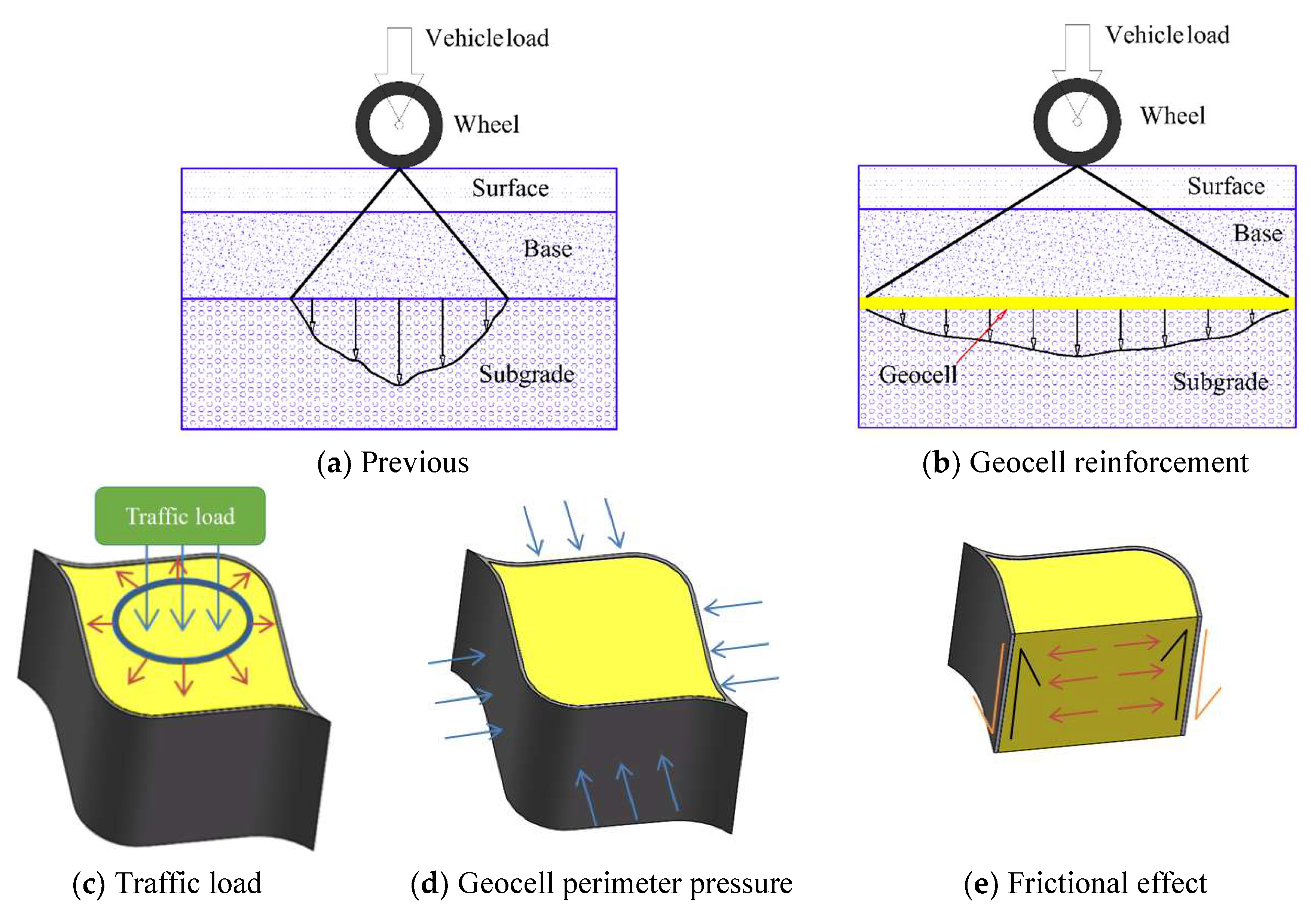
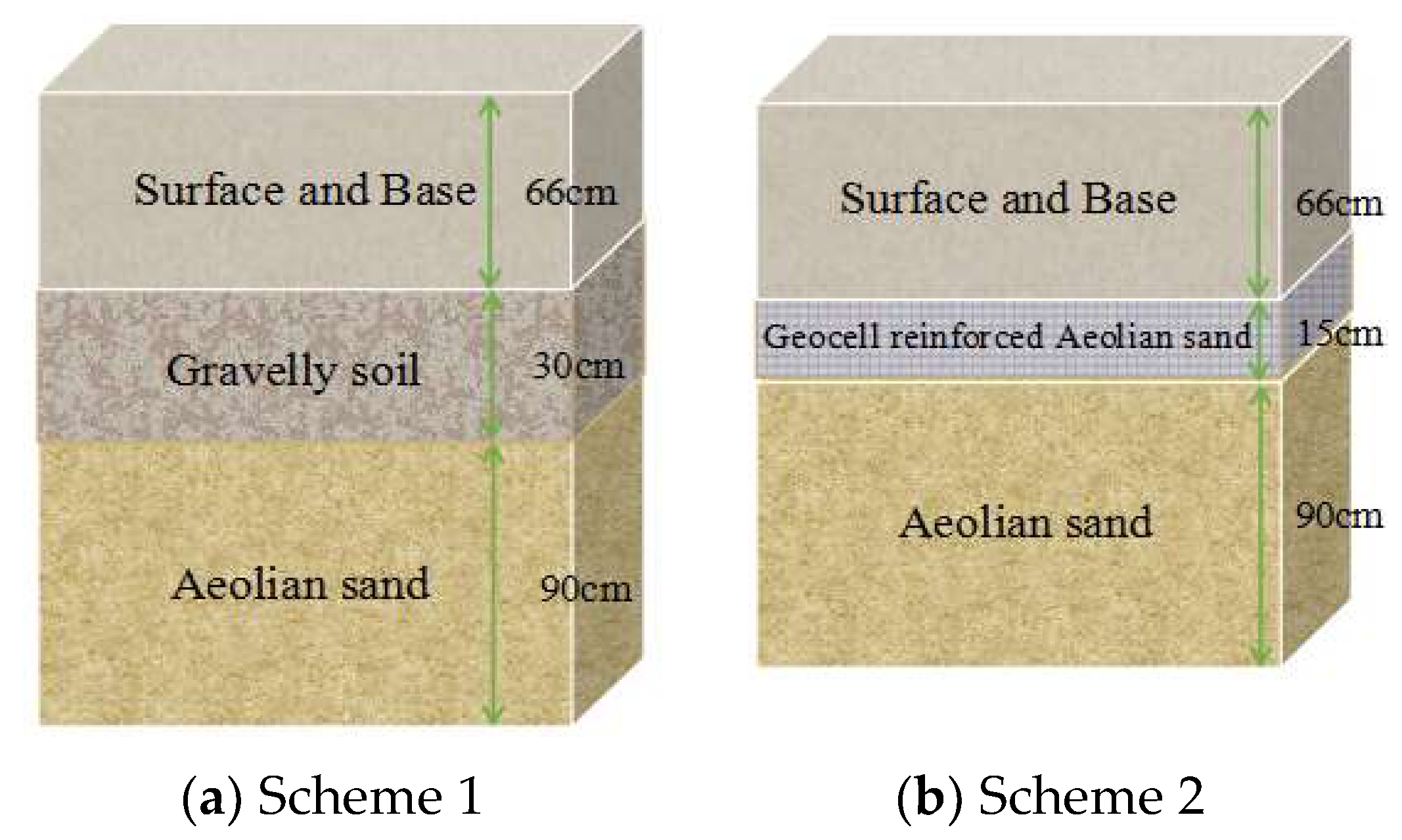
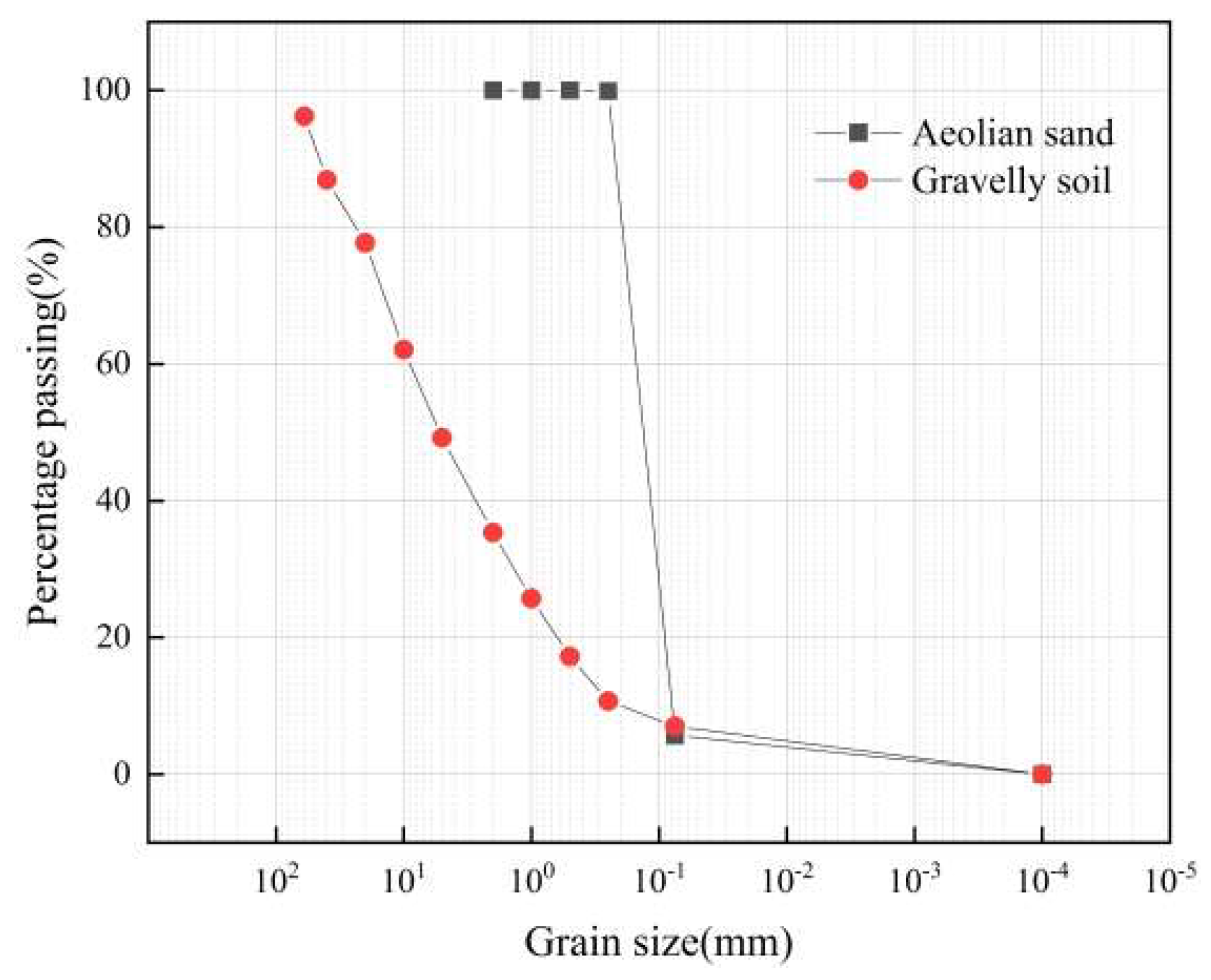
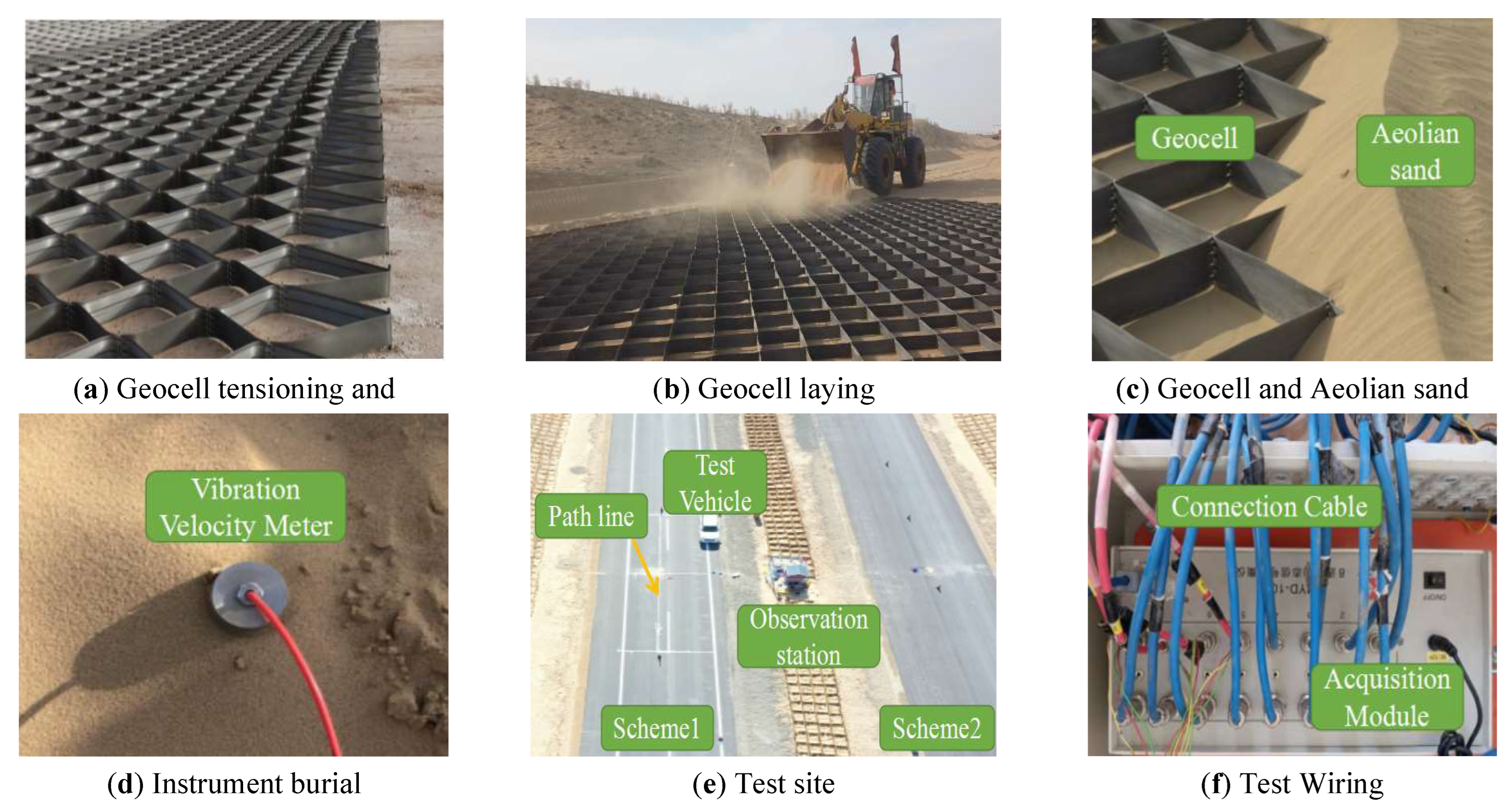
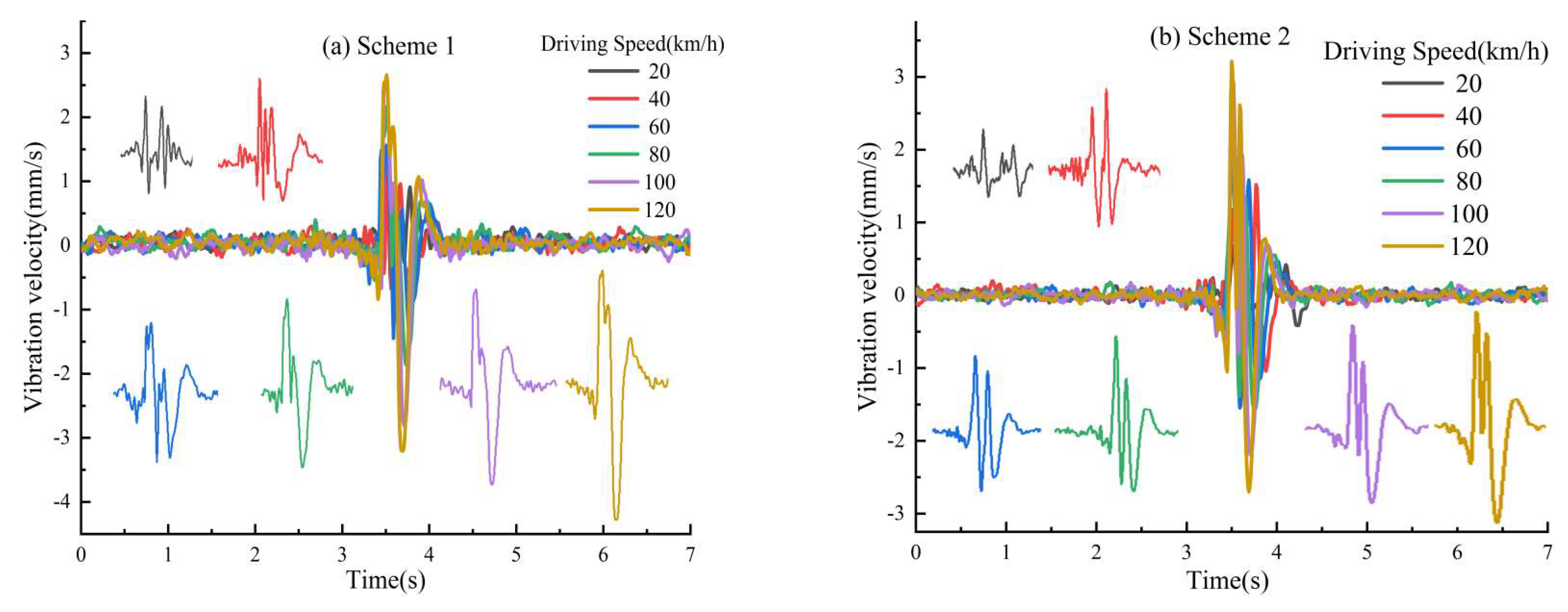

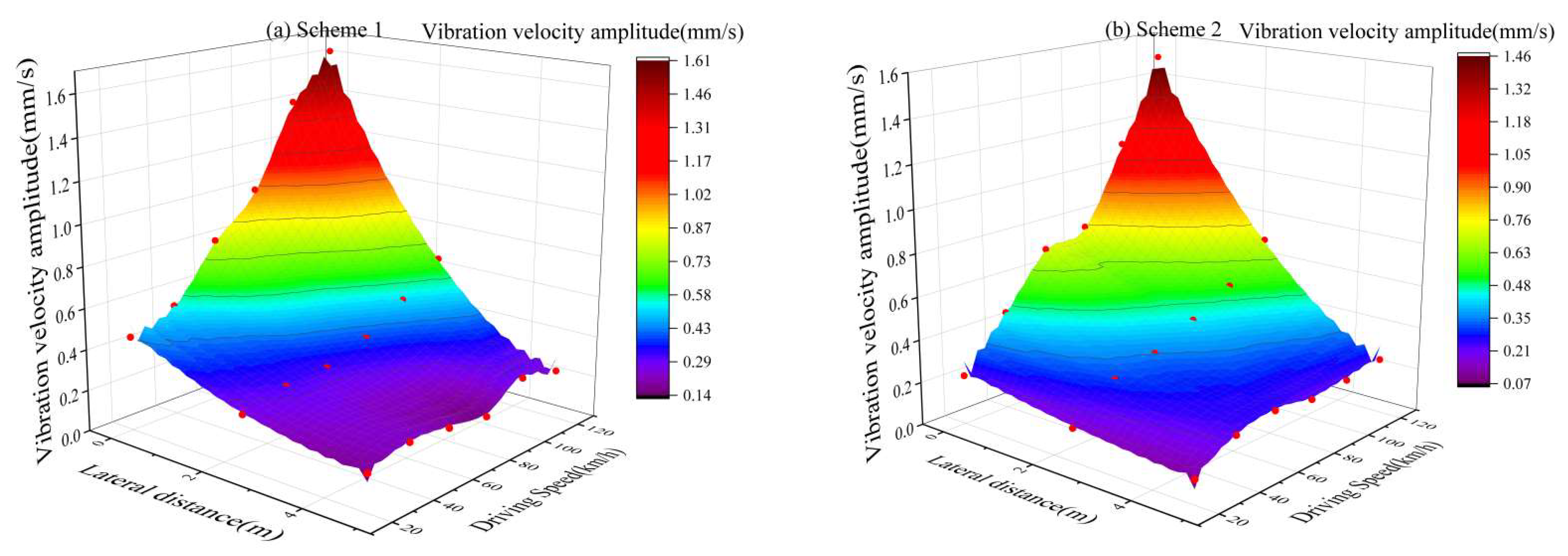
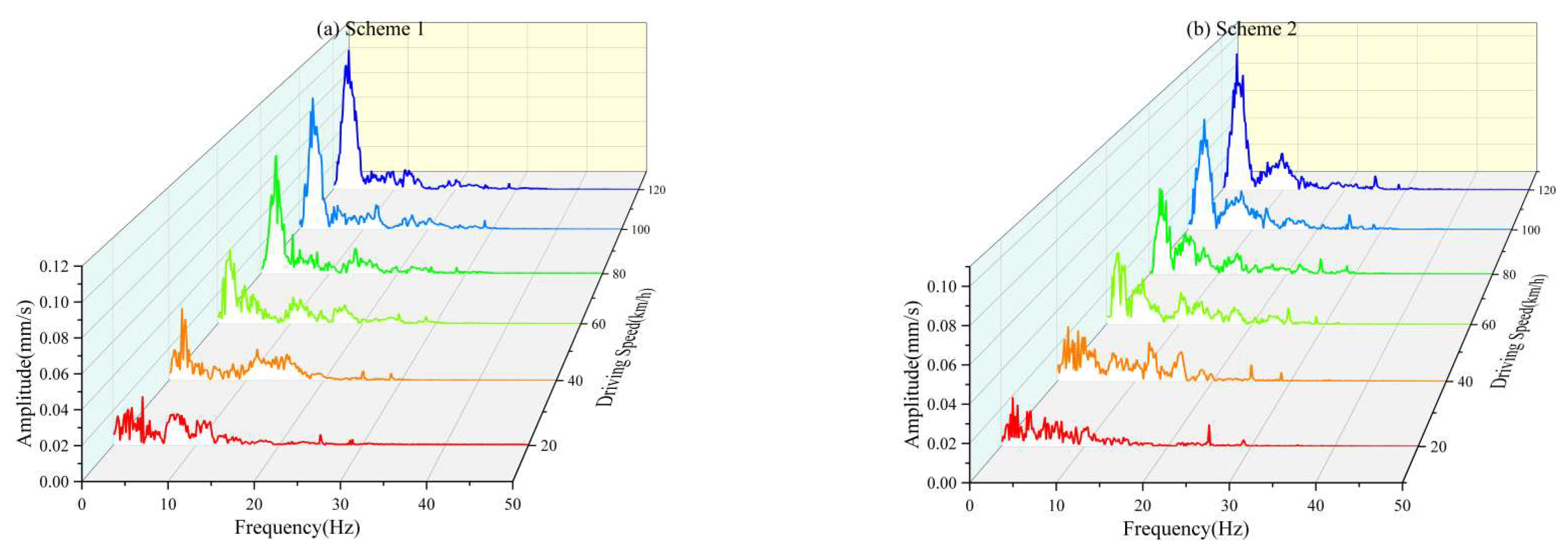
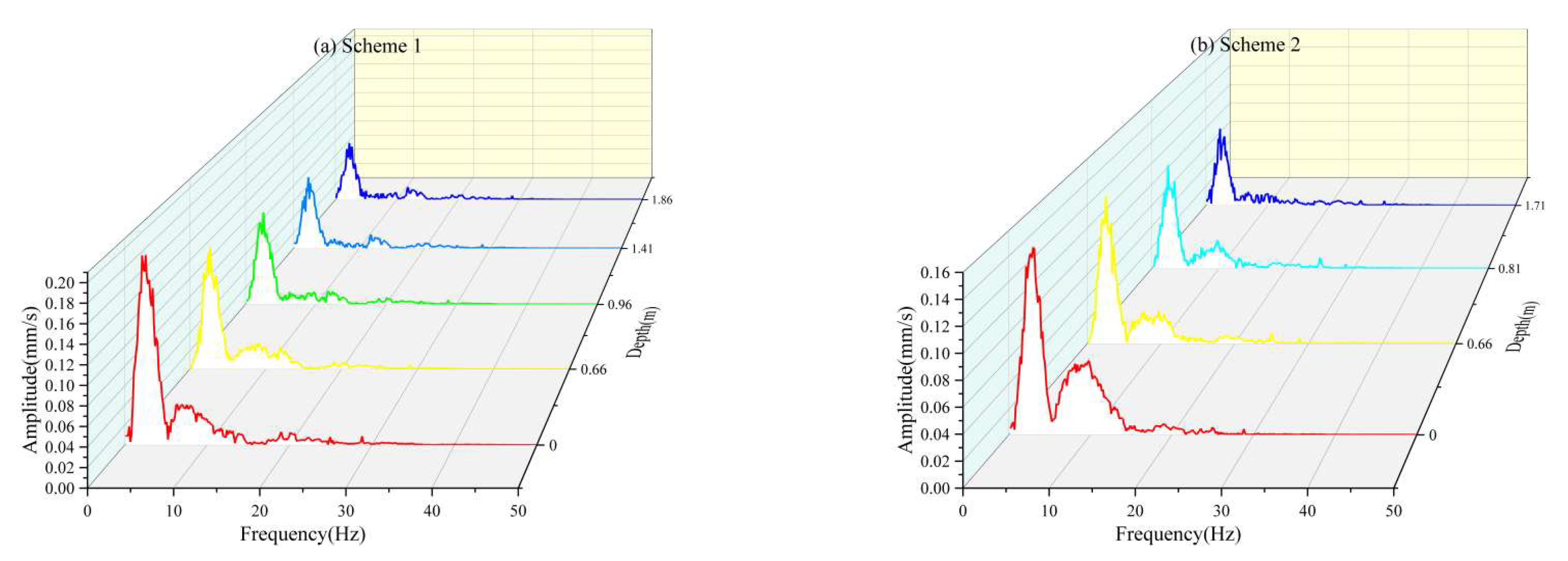
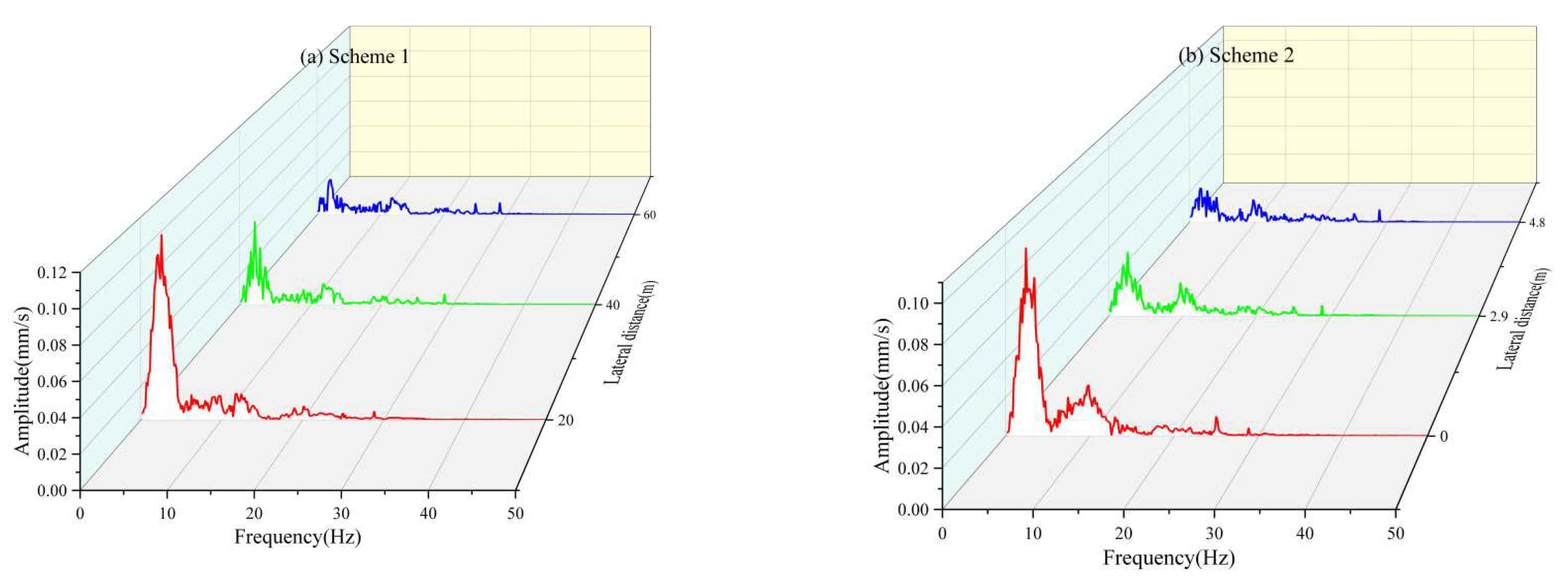


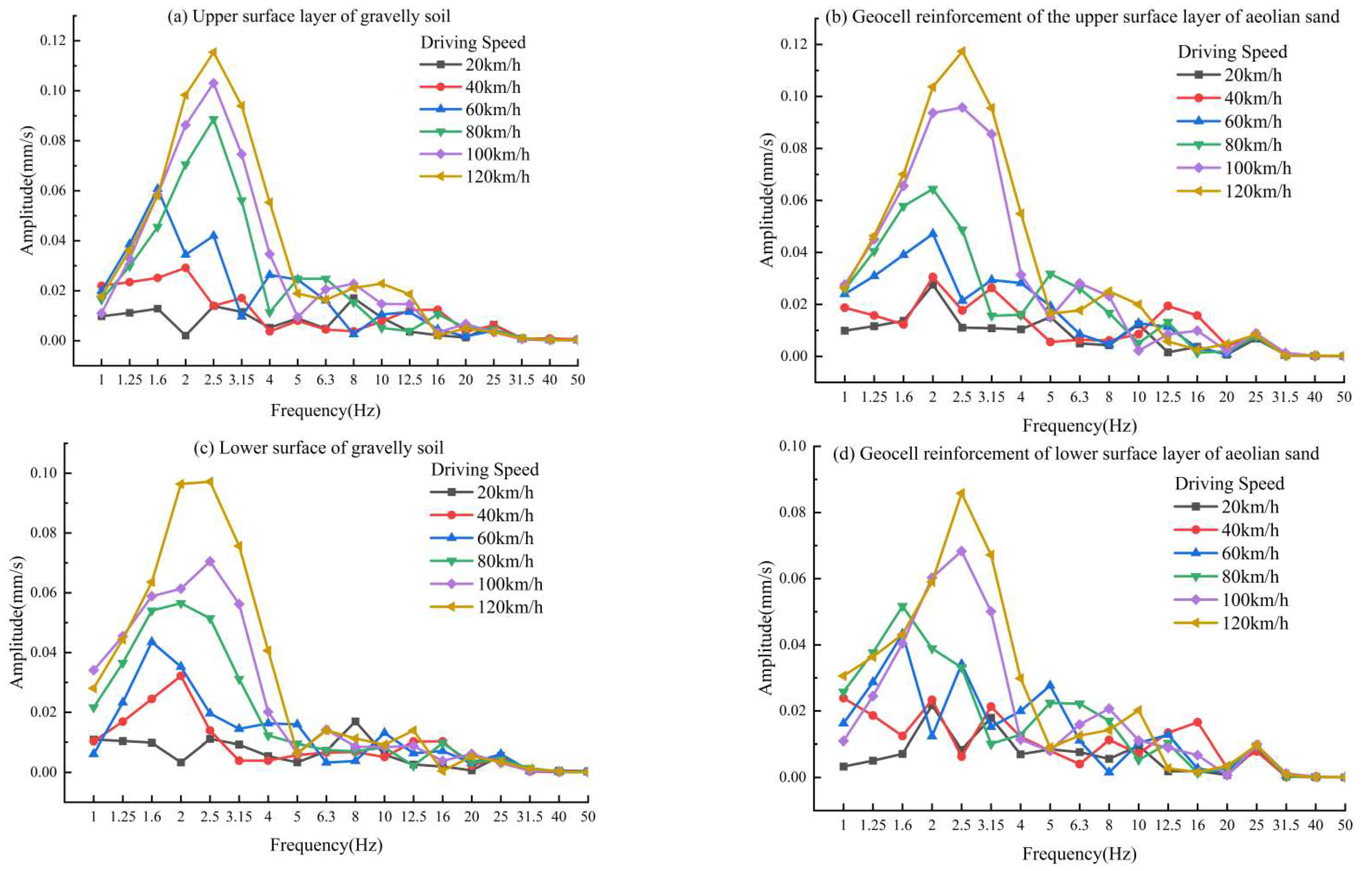
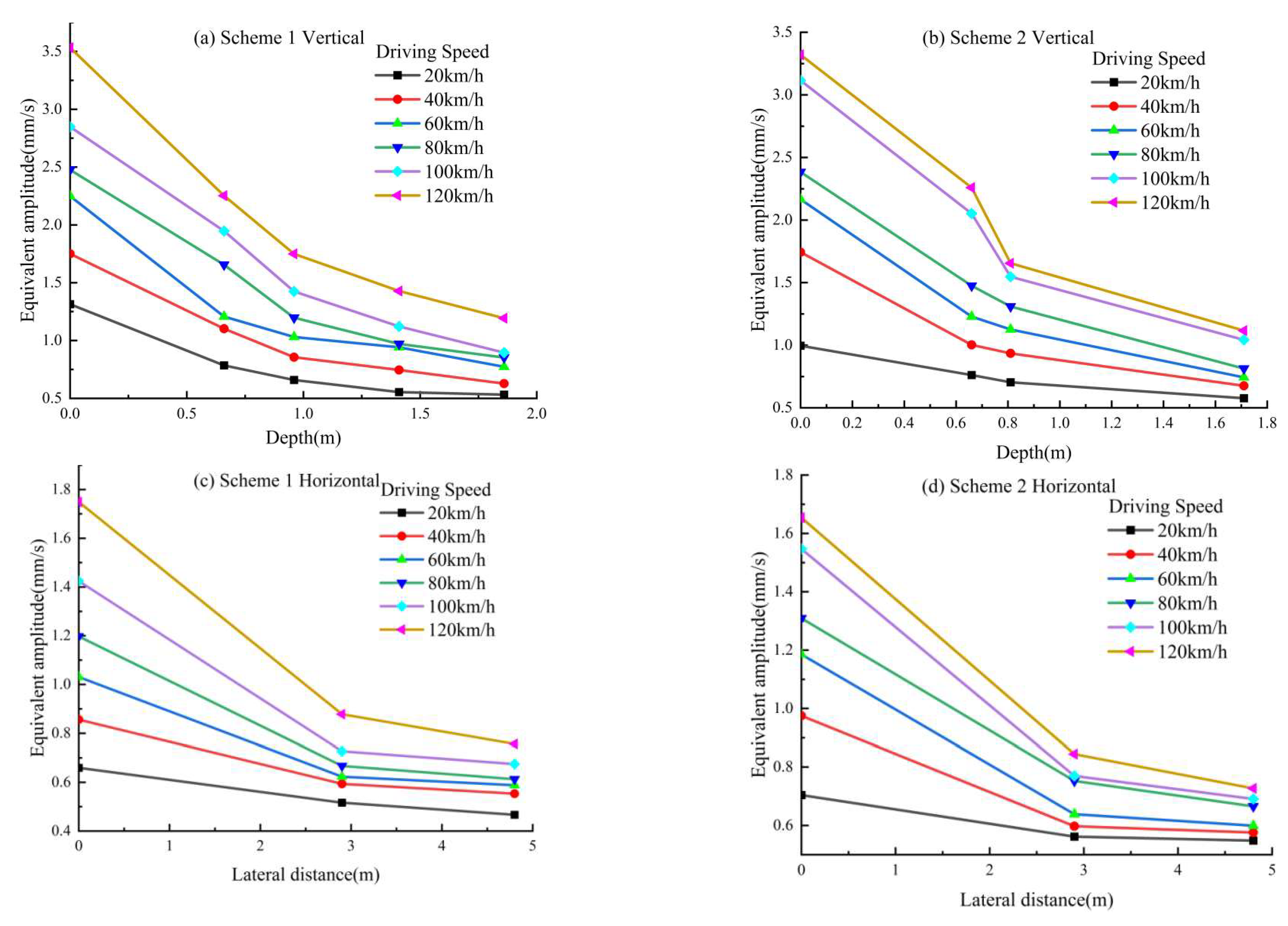
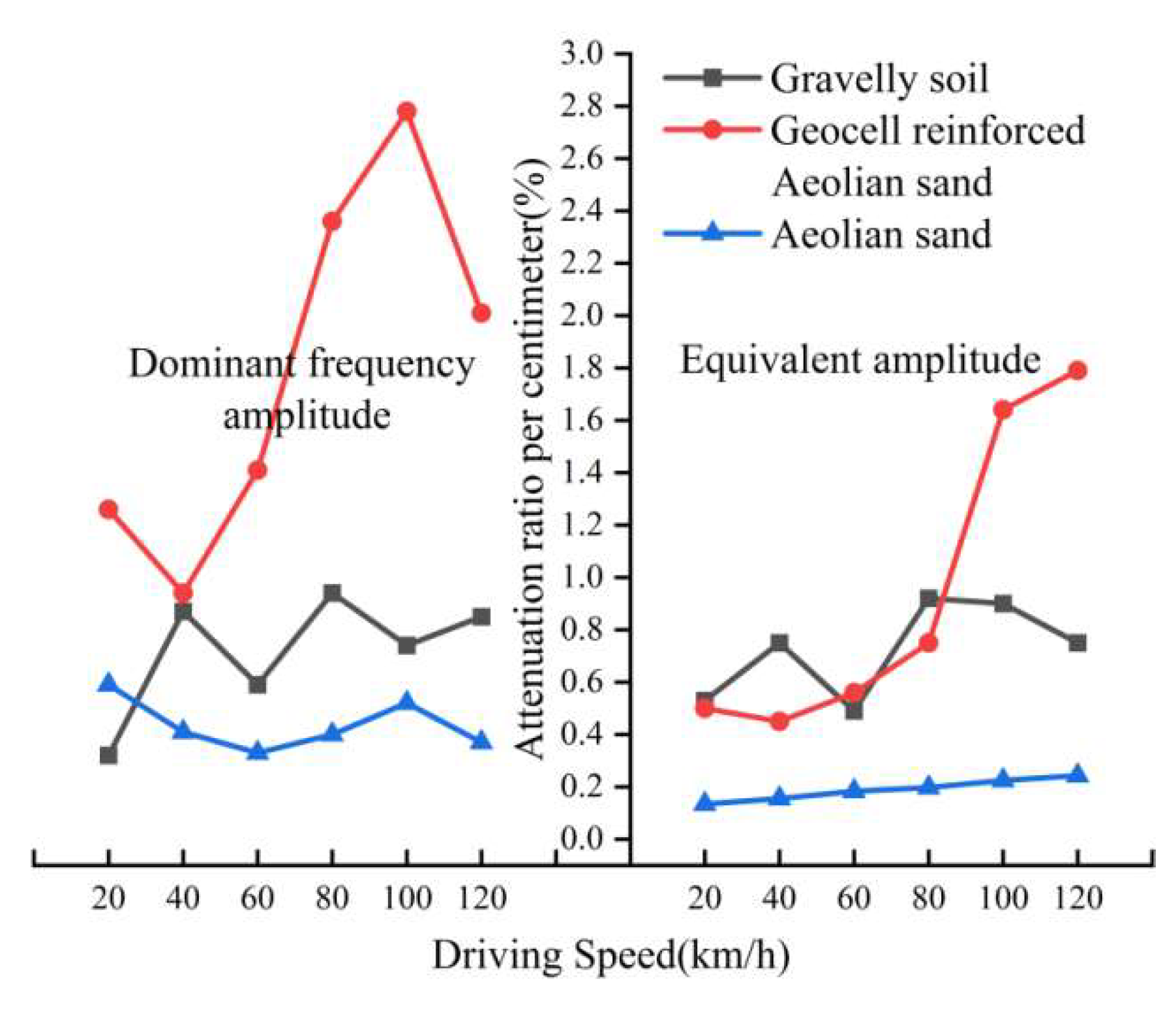

| Upper Roadbed Filler | Natural Density/(g·cm−3) | Water Content/% | Coefficient of Uniformity Cu | Curve Coefficient Cc |
|---|---|---|---|---|
| Aeolian sand (SP) | 1.65 | 1.31 | 1.85 | 0.87 |
| Gravelly soil (GW) | 2.38 | 4.76 | 46.85 | 1.06 |
| Travel Speed | Vertical Layout | Horizontal Layout | ||||||
|---|---|---|---|---|---|---|---|---|
| The Road Surface | 66 cm Below the Road Surface | 112 cm Below the Road Surface | 157 cm Below Road Surface | 202 cm Below Road Surface | Road Center | 290 cm from Road Center | 480 cm from Road Center | |
| 20 km/h | √ | √ | √ | √ | √ | √ | √ | √ |
| 40 km/h | √ | √ | √ | √ | √ | √ | √ | √ |
| 60 km/h | √ | √ | √ | √ | √ | √ | √ | √ |
| 80 km/h | √ | √ | √ | √ | √ | √ | √ | √ |
| 100 km/h | √ | √ | √ | √ | √ | √ | √ | √ |
| 120 km/h | √ | √ | √ | √ | √ | √ | √ | √ |
| Travel Speed | Vertical Layout | Horizontal Layout | ||||||
|---|---|---|---|---|---|---|---|---|
| The Road Surface | 66 cm Below the Road Surface | 81 cm Below the Road Surface | 126 cm Below the Road Surface | 171 cm Below the Road Surface | Road Center | 290 cm from Road Center | 480 cm from Road Center | |
| 20 km/h | √ | √ | √ | X | √ | √ | √ | √ |
| 40 km/h | √ | √ | √ | X | √ | √ | √ | √ |
| 60 km/h | √ | √ | √ | X | √ | √ | √ | √ |
| 80 km/h | √ | √ | √ | X | √ | √ | √ | √ |
| 100 km/h | √ | √ | √ | X | √ | √ | √ | √ |
| 120 km/h | √ | √ | √ | X | √ | √ | √ | √ |
Disclaimer/Publisher’s Note: The statements, opinions and data contained in all publications are solely those of the individual author(s) and contributor(s) and not of MDPI and/or the editor(s). MDPI and/or the editor(s) disclaim responsibility for any injury to people or property resulting from any ideas, methods, instructions or products referred to in the content. |
© 2023 by the authors. Licensee MDPI, Basel, Switzerland. This article is an open access article distributed under the terms and conditions of the Creative Commons Attribution (CC BY) license (https://creativecommons.org/licenses/by/4.0/).
Share and Cite
Gao, B.; Liu, X.; Liu, J.; Song, L.; Shi, Y.; Yang, Y. Field Characterization of Dynamic Response of Geocell-Reinforced Aeolian Sand Subgrade under Live Traffic. Appl. Sci. 2023, 13, 864. https://doi.org/10.3390/app13020864
Gao B, Liu X, Liu J, Song L, Shi Y, Yang Y. Field Characterization of Dynamic Response of Geocell-Reinforced Aeolian Sand Subgrade under Live Traffic. Applied Sciences. 2023; 13(2):864. https://doi.org/10.3390/app13020864
Chicago/Turabian StyleGao, Bin, Xuejun Liu, Jie Liu, Ling Song, Yu Shi, and Ya Yang. 2023. "Field Characterization of Dynamic Response of Geocell-Reinforced Aeolian Sand Subgrade under Live Traffic" Applied Sciences 13, no. 2: 864. https://doi.org/10.3390/app13020864
APA StyleGao, B., Liu, X., Liu, J., Song, L., Shi, Y., & Yang, Y. (2023). Field Characterization of Dynamic Response of Geocell-Reinforced Aeolian Sand Subgrade under Live Traffic. Applied Sciences, 13(2), 864. https://doi.org/10.3390/app13020864






